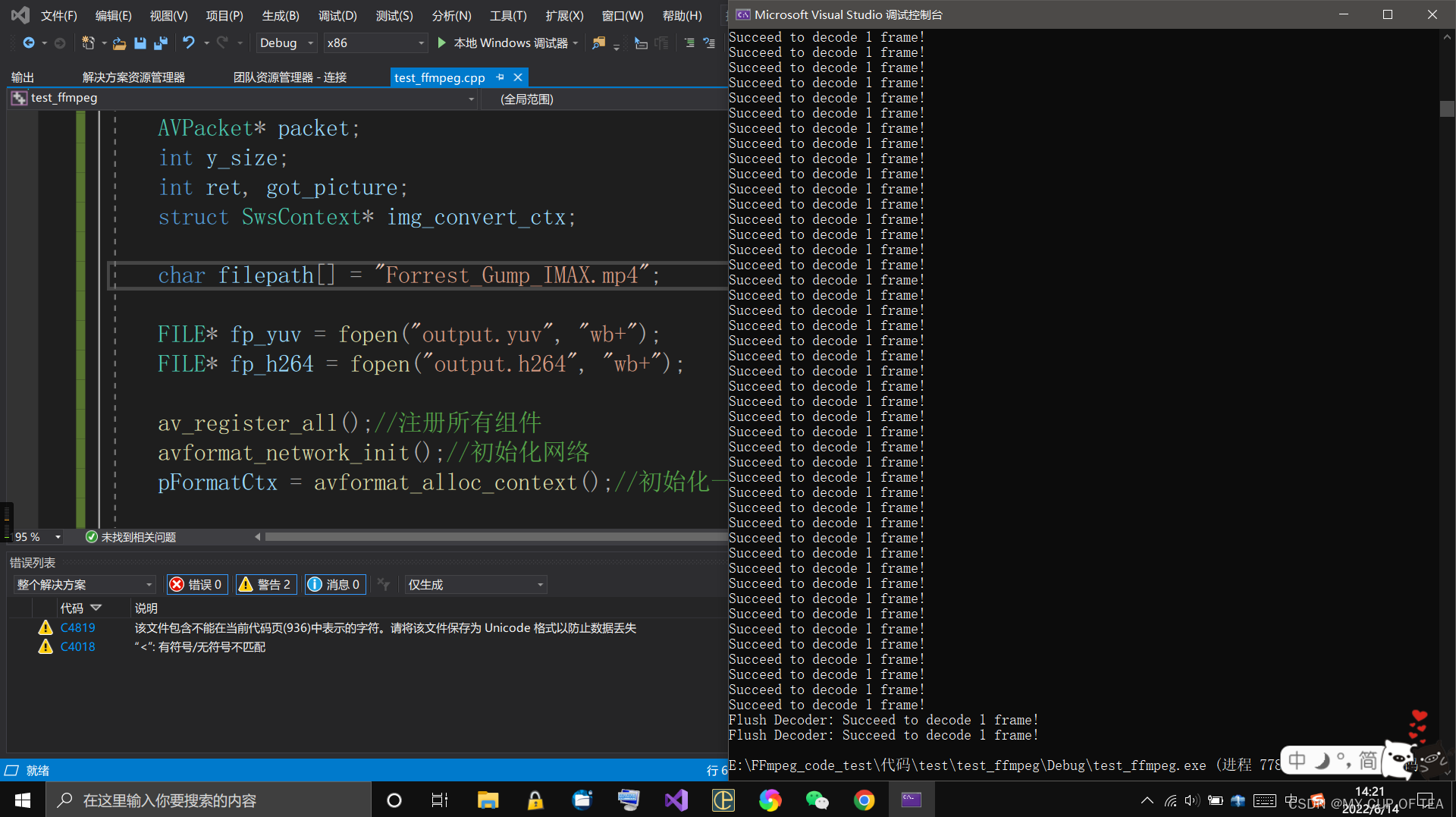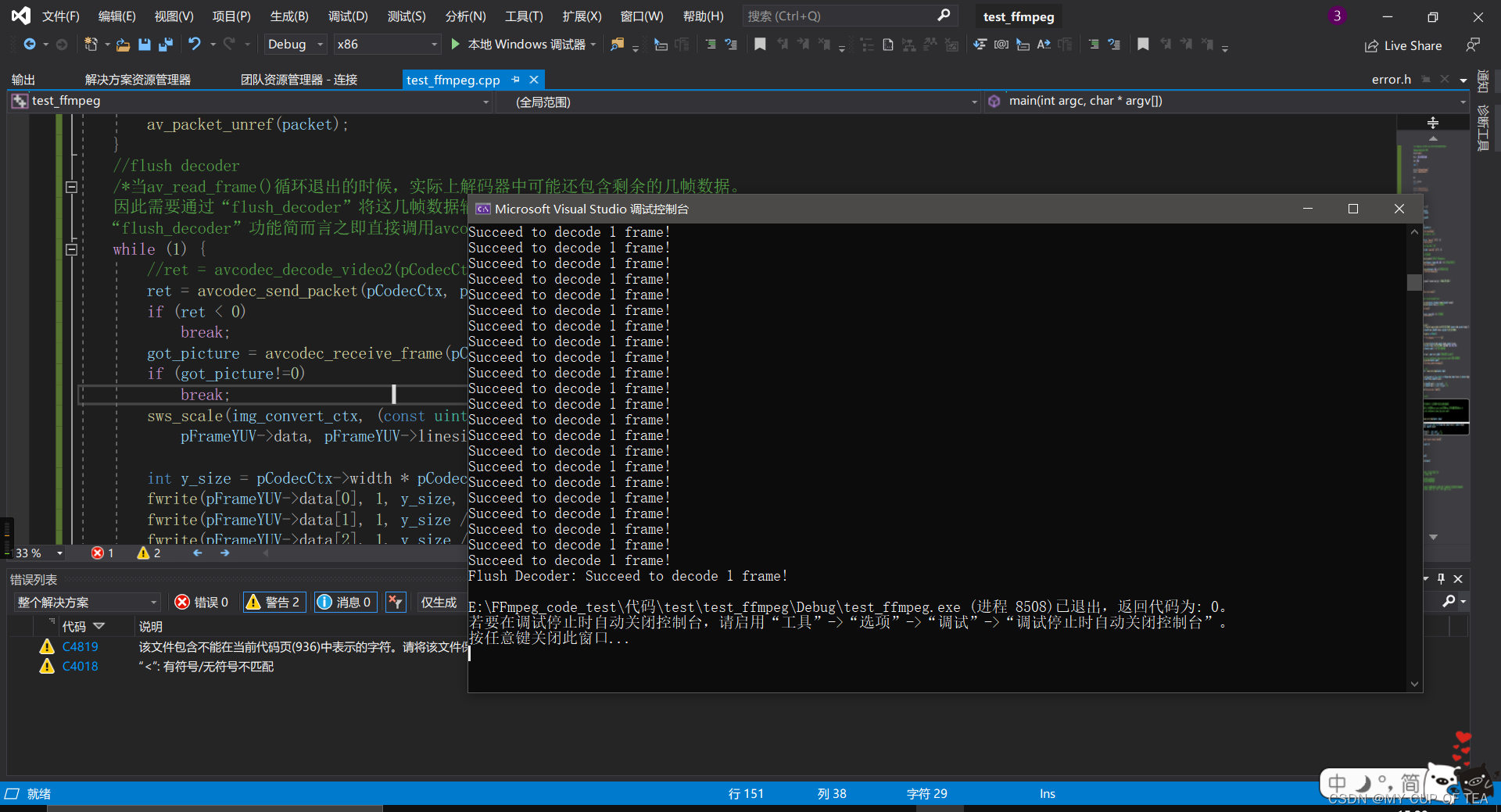旧代码
- 旧代码使用了很多过时的API,这些API使用后,vs会报编译器警告 (级别 3) C4996的错误
- 即 函数被声明为已否决 报 C4996的错误
// test_ffmpeg.cpp : 此文件包含 "main" 函数。程序执行将在此处开始并结束。
//
#define SDL_MAIN_HANDLED
#define __STDC_CONSTANT_MACROS
#pragma warning(disable: 4996)
#include <iostream>
#include <SDL2/SDL.h>
extern "C" {
#include "libavcodec/avcodec.h"
#include "libavformat/avformat.h"
#include "libswscale/swscale.h"
}
int main(int argc,char* argv[])
{
AVFormatContext *pFormatCtx;
int i, videoindex;
AVCodecContext* pCodeCtx;
AVCodec* pCodec;
AVFrame* pFrame, *pFrameYUV;
uint8_t* out_buffer;
AVPacket* packet;
//int y_size;
int ret, got_picture;
struct SwsContext* img_convert_ctx;
//输入文件的路径
char filepath[] = "Titanic.ts";
int frame_cnt;
avformat_network_init();
pFormatCtx = avformat_alloc_context();
if (avformat_open_input(&pFormatCtx, filepath, NULL, NULL) != 0) {
std::cout << "Couldn't open input stream." << std::endl;
return -1;
}
if (avformat_find_stream_info(pFormatCtx, NULL) < 0) {
std::cout << "Couldn't find stream information." << std::endl;
return -1;
}
videoindex = -1;
for (i = 0;i < pFormatCtx->nb_streams;i++) {
if (pFormatCtx->streams[i]->codec->codec_type == AVMEDIA_TYPE_VIDEO) {
videoindex = i;
break;
}
}
if (videoindex == -1) {
std::cout << "Didn't find a video stream." << std::endl;
return -1;
}
pCodeCtx = pFormatCtx->streams[videoindex]->codec;
pCodec = avcodec_find_decoder(pCodeCtx->codec_id);
if (pCodec == NULL) {
std::cout << "Codec not find!" << std::endl;
return -1;
}
if (avcodec_open2(pCodeCtx, pCodec, NULL) < 0) {
std::cout << "Could not open codec!" << std::endl;
return -1;
}
/*
此处添加输出视频信息的代码
取自于pFormatCtx,使用std::cout输出
*/
pFrame = av_frame_alloc();
pFrameYUV = av_frame_alloc();
out_buffer = (uint8_t*)av_malloc(avpicture_get_size(AV_PIX_FMT_YUV420P, pCodeCtx->width, pCodeCtx->height));
avpicture_fill((AVPicture*)pFrameYUV, out_buffer, AV_PIX_FMT_YUV420P, pCodeCtx->width, pCodeCtx->height);
packet = (AVPacket*)av_malloc(sizeof(AVPacket));
//Output Info
std::cout << "--------------------File Information--------------------" << std::endl;
av_dump_format(pFormatCtx, 0, filepath, 0);
std::cout << "--------------------------------------------------------" << std::endl;
img_convert_ctx = sws_getContext(pCodeCtx->width, pCodeCtx->height, pCodeCtx->sw_pix_fmt,
pCodeCtx->width, pCodeCtx->height, AV_PIX_FMT_YUV420P, SWS_BICUBIC, NULL, NULL, NULL);
frame_cnt = 0;
while (av_read_frame(pFormatCtx,packet)>=0)
{
if (packet->stream_index == videoindex) {
/*
在此处添加输出H264码流的代码
取自于packet,使用fwrite()输出
*/
ret = avcodec_decode_video2(pCodeCtx, pFrame, &got_picture, packet);
if (ret < 0) {
std::cout << "Decode Frror!" << std::endl;
return -1;
}
if (got_picture) {
sws_scale(img_convert_ctx, (const uint8_t* const*)pFrame->data, pFrame->linesize, 0, pCodeCtx->height,
pFrameYUV->data, pFrameYUV->linesize);
std::cout << "Decoded frame index"<< frame_cnt << std::endl;
/*
在此处添加输出H264码流的代码
取自于packet,使用fwrite()输出
*/
frame_cnt++;
}
}
av_free_packet(packet);
}
sws_freeContext(img_convert_ctx);
av_frame_free(&pFrameYUV);
av_frame_free(&pFrame);
avcodec_close(pCodeCtx);
avformat_close_input(&pFormatCtx);
return 0;
}
// 运行程序: Ctrl + F5 或调试 >“开始执行(不调试)”菜单
// 调试程序: F5 或调试 >“开始调试”菜单
// 入门使用技巧:
// 1. 使用解决方案资源管理器窗口添加/管理文件
// 2. 使用团队资源管理器窗口连接到源代码管理
// 3. 使用输出窗口查看生成输出和其他消息
// 4. 使用错误列表窗口查看错误
// 5. 转到“项目”>“添加新项”以创建新的代码文件,或转到“项目”>“添加现有项”以将现有代码文件添加到项目
// 6. 将来,若要再次打开此项目,请转到“文件”>“打开”>“项目”并选择 .sln 文件


对应修改
- FFmpeg 被声明为已否决 deprecated_Louis_815的博客-CSDN博客
- api函数替换,在里面搜索ctrl+F,会有英文说明的
- PIX_FMT_YUV420P -> AV_PIX_FMT_YUV420P
- 'AVStream::codec': 被声明为已否决:
- if(pFormatCtx->streams[i]->codec->codec_type==AVMEDIA_TYPE_VIDEO){
- =>
- if(pFormatCtx->streams[i]->codecpar->codec_type==AVMEDIA_TYPE_VIDEO){
- 'AVStream::codec': 被声明为已否决:
- pCodecCtx = pFormatCtx->streams[videoindex]->codec;
- =>
- pCodecCtx = avcodec_alloc_context3(NULL);
- avcodec_parameters_to_context(pCodecCtx, pFormatCtx->streams[videoindex]->codecpar);
- 'avpicture_get_size': 被声明为已否决:
- avpicture_get_size(AV_PIX_FMT_YUV420P, pCodecCtx->width, pCodecCtx->height)
- =>
- #include "libavutil/imgutils.h"
- av_image_get_buffer_size(AV_PIX_FMT_YUV420P, pCodecCtx->width, pCodecCtx->height, 1)
- 'avpicture_fill': 被声明为已否决:
- avpicture_fill((AVPicture *)pFrameYUV, out_buffer, AV_PIX_FMT_YUV420P, pCodecCtx->width, pCodecCtx->height);
- =>
- av_image_fill_arrays(pFrameYUV->data, pFrameYUV->linesize, out_buffer, AV_PIX_FMT_YUV420P, pCodecCtx->width, pCodecCtx->height, 1);
- 'avcodec_decode_video2': 被声明为已否决:
- ret = avcodec_decode_video2(pCodecCtx, pFrame, &got_picture, packet); //got_picture_ptr Zero if no frame could be decompressed
- =>
- ret = avcodec_send_packet(pCodecCtx, packet);
- got_picture = avcodec_receive_frame(pCodecCtx, pFrame); //got_picture = 0 success, a frame was returned
- //注意:got_picture含义相反
- 或者:
- int ret = avcodec_send_packet(aCodecCtx, &pkt);
- if (ret != 0)
- {
- prinitf("%s/n","error");
- return;
- }
- while( avcodec_receive_frame(aCodecCtx, &frame) == 0){
- //读取到一帧音频或者视频
- //处理解码后音视频 frame
- }
- 'av_free_packet': 被声明为已否决:
- av_free_packet(packet);
- =>
- av_packet_unref(packet);
- 本文代码 未涉及
- avcodec_decode_audio4:被声明为已否决:
- int ret = avcodec_send_packet(aCodecCtx, &pkt);
- if (ret != 0){prinitf("%s/n","error");}
- while( avcodec_receive_frame(aCodecCtx, &frame) == 0){
- //读取到一帧音频或者视频
- //处理解码后音视频 frame
- }
修改后的代码
// test_ffmpeg.cpp : 此文件包含 "main" 函数。程序执行将在此处开始并结束。
//
#define SDL_MAIN_HANDLED
#define __STDC_CONSTANT_MACROS
#pragma warning(disable: 4819)
#include <iostream>
#include <SDL2/SDL.h>
extern "C" {
#include "libavcodec/avcodec.h"
#include "libavformat/avformat.h"
#include "libswscale/swscale.h"
#include "libavutil/imgutils.h"
}
int main(int argc,char* argv[])
{
AVFormatContext *pFormatCtx;
int i, videoindex;
AVCodecContext* pCodeCtx;
AVCodec* pCodec;
AVFrame* pFrame, *pFrameYUV;
uint8_t* out_buffer;
AVPacket* packet;
//int y_size;
int ret, got_picture;
struct SwsContext* img_convert_ctx;
//输入文件的路径
char filepath[] = "Titanic.ts";
int frame_cnt;
avformat_network_init();
pFormatCtx = avformat_alloc_context();
if (avformat_open_input(&pFormatCtx, filepath, NULL, NULL) != 0) {
std::cout << "Couldn't open input stream." << std::endl;
return -1;
}
if (avformat_find_stream_info(pFormatCtx, NULL) < 0) {
std::cout << "Couldn't find stream information." << std::endl;
return -1;
}
videoindex = -1;
for (i = 0;i < pFormatCtx->nb_streams;i++) {
if (pFormatCtx->streams[i]->codecpar->codec_type == AVMEDIA_TYPE_VIDEO) {
videoindex = i;
break;
}
}
if (videoindex == -1) {
std::cout << "Didn't find a video stream." << std::endl;
return -1;
}
pCodeCtx = avcodec_alloc_context3(NULL);
avcodec_parameters_to_context(pCodeCtx, pFormatCtx->streams[videoindex]->codecpar);
pCodec = avcodec_find_decoder(pCodeCtx->codec_id);
if (pCodec == NULL) {
std::cout << "Codec not find!" << std::endl;
return -1;
}
if (avcodec_open2(pCodeCtx, pCodec, NULL) < 0) {
std::cout << "Could not open codec!" << std::endl;
return -1;
}
/*
此处添加输出视频信息的代码
取自于pFormatCtx,使用std::cout输出
*/
pFrame = av_frame_alloc();
pFrameYUV = av_frame_alloc();
out_buffer = (uint8_t*)av_malloc(av_image_get_buffer_size(AV_PIX_FMT_YUV420P, pCodeCtx->width, pCodeCtx->height,1));
av_image_fill_arrays(pFrameYUV->data,pFrameYUV->linesize,out_buffer,AV_PIX_FMT_YUV420P,pCodeCtx->width,pCodeCtx->height,1);
packet = (AVPacket*)av_malloc(sizeof(AVPacket));
//Output Info
std::cout << "--------------------File Information--------------------" << std::endl;
av_dump_format(pFormatCtx, 0, filepath, 0);
std::cout << "--------------------------------------------------------" << std::endl;
img_convert_ctx = sws_getContext(pCodeCtx->width, pCodeCtx->height, pCodeCtx->sw_pix_fmt,
pCodeCtx->width, pCodeCtx->height, AV_PIX_FMT_YUV420P, SWS_BICUBIC, NULL, NULL, NULL);
frame_cnt = 0;
while (av_read_frame(pFormatCtx,packet)>=0)
{
if (packet->stream_index == videoindex) {
/*
在此处添加输出H264码流的代码
取自于packet,使用fwrite()输出
*/
ret = avcodec_send_packet(pCodeCtx, packet);
//注意 got_picture=0 success,a frame was returned
got_picture = avcodec_receive_frame(pCodeCtx, pFrame);
if (ret < 0) {
std::cout << "Decode Frror!" << std::endl;
return -1;
}
if (got_picture) {
sws_scale(img_convert_ctx, (const uint8_t* const*)pFrame->data, pFrame->linesize, 0, pCodeCtx->height,
pFrameYUV->data, pFrameYUV->linesize);
std::cout << "Decoded frame index"<< frame_cnt << std::endl;
/*
在此处添加输出H264码流的代码
取自于packet,使用fwrite()输出
*/
frame_cnt++;
}
}
av_packet_unref(packet);
}
sws_freeContext(img_convert_ctx);
av_frame_free(&pFrameYUV);
av_frame_free(&pFrame);
avcodec_close(pCodeCtx);
avformat_close_input(&pFormatCtx);
return 0;
}
// 运行程序: Ctrl + F5 或调试 >“开始执行(不调试)”菜单
// 调试程序: F5 或调试 >“开始调试”菜单
// 入门使用技巧:
// 1. 使用解决方案资源管理器窗口添加/管理文件
// 2. 使用团队资源管理器窗口连接到源代码管理
// 3. 使用输出窗口查看生成输出和其他消息
// 4. 使用错误列表窗口查看错误
// 5. 转到“项目”>“添加新项”以创建新的代码文件,或转到“项目”>“添加现有项”以将现有代码文件添加到项目
// 6. 将来,若要再次打开此项目,请转到“文件”>“打开”>“项目”并选择 .sln 文件
问题仍未解决

- 还是同一个错误
- Assertion desc failed at C:\Users\32157\vcpkg\buildtrees\ffmpeg\src\n4.4.1-070f385ab7.clean\libswscale\swscale_internal.h:677
再次修改代码
// test_ffmpeg.cpp : 此文件包含 "main" 函数。程序执行将在此处开始并结束。
//
/*
#define SDL_MAIN_HANDLED
#define __STDC_CONSTANT_MACROS
#pragma warning(disable: 4819)
#include <iostream>
#include <SDL2/SDL.h>
extern "C" {
#include "libavcodec/avcodec.h"
#include "libavformat/avformat.h"
#include "libswscale/swscale.h"
#include "libavutil/imgutils.h"
}
*/
#pragma warning(disable: 4996)
#include <stdio.h>
#define __STDC_CONSTANT_MACROS
#ifdef _WIN32
//Windows
extern "C"
{
#include "libavcodec/avcodec.h"
#include "libavformat/avformat.h"
#include "libswscale/swscale.h"
};
#else
//Linux...
#ifdef __cplusplus
extern "C"
{
#endif
#include <libavcodec/avcodec.h>
#include <libavformat/avformat.h>
#include <libswscale/swscale.h>
#ifdef __cplusplus
};
#endif
#endif
int main(int argc, char* argv[])
{
AVFormatContext* pFormatCtx;
int i, videoindex;
AVCodecContext* pCodecCtx;
AVCodec* pCodec;
AVFrame* pFrame, * pFrameYUV;
uint8_t* out_buffer;
AVPacket* packet;
int y_size;
int ret, got_picture;
struct SwsContext* img_convert_ctx;
char filepath[] = "Forrest_Gump_IMAX.mp4";
FILE* fp_yuv = fopen("output.yuv", "wb+");
FILE* fp_h264 = fopen("output.h264", "wb+");
av_register_all();//注册所有组件
avformat_network_init();//初始化网络
pFormatCtx = avformat_alloc_context();//初始化一个AVFormatContext
if (avformat_open_input(&pFormatCtx, filepath, NULL, NULL) != 0) {//打开输入的视频文件
printf("Couldn't open input stream.\n");
return -1;
}
if (avformat_find_stream_info(pFormatCtx, NULL) < 0) {//获取视频文件信息
printf("Couldn't find stream information.\n");
return -1;
}
videoindex = -1;
for (i = 0; i < pFormatCtx->nb_streams; i++)
if (pFormatCtx->streams[i]->codec->codec_type == AVMEDIA_TYPE_VIDEO) {
videoindex = i;
break;
}
if (videoindex == -1) {
printf("Didn't find a video stream.\n");
return -1;
}
pCodecCtx = pFormatCtx->streams[videoindex]->codec;
pCodec = avcodec_find_decoder(pCodecCtx->codec_id);//查找解码器
if (pCodec == NULL) {
printf("Codec not found.\n");
return -1;
}
if (avcodec_open2(pCodecCtx, pCodec, NULL) < 0) {//打开解码器
printf("Could not open codec.\n");
return -1;
}
pFrame = av_frame_alloc();
pFrameYUV = av_frame_alloc();
out_buffer = (uint8_t*)av_malloc(avpicture_get_size(AV_PIX_FMT_YUV420P, pCodecCtx->width, pCodecCtx->height));
avpicture_fill((AVPicture*)pFrameYUV, out_buffer, AV_PIX_FMT_YUV420P, pCodecCtx->width, pCodecCtx->height);
packet = (AVPacket*)av_malloc(sizeof(AVPacket));
//Output Info-----------------------------
printf("--------------- File Information ----------------\n");
av_dump_format(pFormatCtx, 0, filepath, 0);
printf("-------------------------------------------------\n");
img_convert_ctx = sws_getContext(pCodecCtx->width, pCodecCtx->height, pCodecCtx->pix_fmt,
pCodecCtx->width, pCodecCtx->height, AV_PIX_FMT_YUV420P, SWS_BICUBIC, NULL, NULL, NULL);
while (av_read_frame(pFormatCtx, packet) >= 0) {//读取一帧压缩数据
if (packet->stream_index == videoindex) {
fwrite(packet->data, 1, packet->size, fp_h264); //把H264数据写入fp_h264文件
ret = avcodec_decode_video2(pCodecCtx, pFrame, &got_picture, packet);//解码一帧压缩数据
if (ret < 0) {
printf("Decode Error.\n");
return -1;
}
if (got_picture) {
sws_scale(img_convert_ctx, (const uint8_t* const*)pFrame->data, pFrame->linesize, 0, pCodecCtx->height,
pFrameYUV->data, pFrameYUV->linesize);
y_size = pCodecCtx->width * pCodecCtx->height;
fwrite(pFrameYUV->data[0], 1, y_size, fp_yuv); //Y
fwrite(pFrameYUV->data[1], 1, y_size / 4, fp_yuv); //U
fwrite(pFrameYUV->data[2], 1, y_size / 4, fp_yuv); //V
printf("Succeed to decode 1 frame!\n");
}
}
av_free_packet(packet);
}
//flush decoder
/*当av_read_frame()循环退出的时候,实际上解码器中可能还包含剩余的几帧数据。
因此需要通过“flush_decoder”将这几帧数据输出。
“flush_decoder”功能简而言之即直接调用avcodec_decode_video2()获得AVFrame,而不再向解码器传递AVPacket。*/
while (1) {
ret = avcodec_decode_video2(pCodecCtx, pFrame, &got_picture, packet);
if (ret < 0)
break;
if (!got_picture)
break;
sws_scale(img_convert_ctx, (const uint8_t* const*)pFrame->data, pFrame->linesize, 0, pCodecCtx->height,
pFrameYUV->data, pFrameYUV->linesize);
int y_size = pCodecCtx->width * pCodecCtx->height;
fwrite(pFrameYUV->data[0], 1, y_size, fp_yuv); //Y
fwrite(pFrameYUV->data[1], 1, y_size / 4, fp_yuv); //U
fwrite(pFrameYUV->data[2], 1, y_size / 4, fp_yuv); //V
printf("Flush Decoder: Succeed to decode 1 frame!\n");
}
sws_freeContext(img_convert_ctx);
//关闭文件以及释放内存
fclose(fp_yuv);
fclose(fp_h264);
av_frame_free(&pFrameYUV);
av_frame_free(&pFrame);
avcodec_close(pCodecCtx);
avformat_close_input(&pFormatCtx);
return 0;
}
// 运行程序: Ctrl + F5 或调试 >“开始执行(不调试)”菜单
// 调试程序: F5 或调试 >“开始调试”菜单
// 入门使用技巧:
// 1. 使用解决方案资源管理器窗口添加/管理文件
// 2. 使用团队资源管理器窗口连接到源代码管理
// 3. 使用输出窗口查看生成输出和其他消息
// 4. 使用错误列表窗口查看错误
// 5. 转到“项目”>“添加新项”以创建新的代码文件,或转到“项目”>“添加现有项”以将现有代码文件添加到项目
// 6. 将来,若要再次打开此项目,请转到“文件”>“打开”>“项目”并选择 .sln 文件

最后修改代码
- fopen 和 fopen_s 之间的差异
- avcodec_send_packet 和 avcodec_receive_frame 替代 avcodec_decode_video2
// test_ffmpeg.cpp : 此文件包含 "main" 函数。程序执行将在此处开始并结束。
//
//#pragma warning(disable: 4996)
#include <stdio.h>
#define __STDC_CONSTANT_MACROS
#ifdef _WIN32
//Windows
extern "C"
{
#include "libavcodec/avcodec.h"
#include "libavformat/avformat.h"
#include "libswscale/swscale.h"
#include "libavutil/imgutils.h"
};
#else
//Linux...
#ifdef __cplusplus
extern "C"
{
#endif
#include <libavcodec/avcodec.h>
#include <libavformat/avformat.h>
#include <libswscale/swscale.h>
#ifdef __cplusplus
};
#endif
#include <cerrno>
#endif
int main(int argc, char* argv[])
{
AVFormatContext* pFormatCtx;
int i, videoindex;
AVCodecContext* pCodecCtx;
AVCodec* pCodec;
AVFrame* pFrame, * pFrameYUV;
uint8_t* out_buffer;
AVPacket* packet;
int y_size;
int ret, got_picture;
struct SwsContext* img_convert_ctx;
char filepath[] = "Forrest_Gump_IMAX.mp4";
//FILE* fp_yuv = fopen("output.yuv", "wb+");
errno_t err;
FILE* fp_yuv = NULL;
if ((err = fopen_s(&fp_yuv, "output.yuv", "wb+")) != 0) {
printf("Couldn't open fp_yuv.\n");
}
//FILE* fp_h264 = fopen("output.h264", "wb+");
FILE* fp_h264 = NULL;
if ((err = fopen_s(&fp_h264, "output.h264", "wb+")) != 0) {
printf("Couldn't open fp_h264.\n");
}
//av_register_all();//注册所有组件
avformat_network_init();//初始化网络
pFormatCtx = avformat_alloc_context();//初始化一个AVFormatContext
if (avformat_open_input(&pFormatCtx, filepath, NULL, NULL) != 0) {//打开输入的视频文件
printf("Couldn't open input stream.\n");
return -1;
}
if (avformat_find_stream_info(pFormatCtx, NULL) < 0) {//获取视频文件信息
printf("Couldn't find stream information.\n");
return -1;
}
videoindex = -1;
for (i = 0; i < pFormatCtx->nb_streams; i++)
if (pFormatCtx->streams[i]->codecpar->codec_type == AVMEDIA_TYPE_VIDEO) {
videoindex = i;
break;
}
if (videoindex == -1) {
printf("Didn't find a video stream.\n");
return -1;
}
//pCodecCtx = pFormatCtx->streams[videoindex]->codec;
pCodecCtx = avcodec_alloc_context3(NULL);
avcodec_parameters_to_context(pCodecCtx, pFormatCtx->streams[videoindex]->codecpar);
pCodec = avcodec_find_decoder(pCodecCtx->codec_id);//查找解码器
if (pCodec == NULL) {
printf("Codec not found.\n");
return -1;
}
if (avcodec_open2(pCodecCtx, pCodec, NULL) < 0) {//打开解码器
printf("Could not open codec.\n");
return -1;
}
pFrame = av_frame_alloc();
pFrameYUV = av_frame_alloc();
out_buffer = (uint8_t*)av_malloc(av_image_get_buffer_size(AV_PIX_FMT_YUV420P, pCodecCtx->width, pCodecCtx->height,1));
//avpicture_fill((AVPicture*)pFrameYUV, out_buffer, AV_PIX_FMT_YUV420P, pCodecCtx->width, pCodecCtx->height);
av_image_fill_arrays(pFrameYUV->data, pFrameYUV->linesize, out_buffer, AV_PIX_FMT_YUV420P,
pCodecCtx->width, pCodecCtx->height, 1);
packet = (AVPacket*)av_malloc(sizeof(AVPacket));
//Output Info-----------------------------
printf("--------------- File Information ----------------\n");
av_dump_format(pFormatCtx, 0, filepath, 0);
printf("-------------------------------------------------\n");
img_convert_ctx = sws_getContext(pCodecCtx->width, pCodecCtx->height, pCodecCtx->pix_fmt,
pCodecCtx->width, pCodecCtx->height, AV_PIX_FMT_YUV420P, SWS_BICUBIC, NULL, NULL, NULL);
while (av_read_frame(pFormatCtx, packet) >= 0) {//读取一帧压缩数据
if (packet->stream_index == videoindex) {
fwrite(packet->data, 1, packet->size, fp_h264); //把H264数据写入fp_h264文件
//ret = avcodec_decode_video2(pCodecCtx, pFrame, &got_picture, packet);//解码一帧压缩数据
ret = avcodec_send_packet(pCodecCtx, packet);
if (ret < 0) {
printf("Error sending a packet for decoding.\n");
return -1;
}
//while (ret >= 0) {
got_picture = avcodec_receive_frame(pCodecCtx, pFrame);
//缺失错误处理和检测
if (got_picture==0) {
sws_scale(img_convert_ctx, (const uint8_t* const*)pFrame->data, pFrame->linesize, 0, pCodecCtx->height,
pFrameYUV->data, pFrameYUV->linesize);
y_size = pCodecCtx->width * pCodecCtx->height;
fwrite(pFrameYUV->data[0], 1, y_size, fp_yuv); //Y
fwrite(pFrameYUV->data[1], 1, y_size / 4, fp_yuv); //U
fwrite(pFrameYUV->data[2], 1, y_size / 4, fp_yuv); //V
printf("Succeed to decode 1 frame!\n");
}
//}
}
//av_free_packet(packet);
av_packet_unref(packet);
}
//flush decoder
/*当av_read_frame()循环退出的时候,实际上解码器中可能还包含剩余的几帧数据。
因此需要通过“flush_decoder”将这几帧数据输出。
“flush_decoder”功能简而言之即直接调用avcodec_decode_video2()获得AVFrame,而不再向解码器传递AVPacket。*/
while (1) {
//ret = avcodec_decode_video2(pCodecCtx, pFrame, &got_picture, packet);
ret = avcodec_send_packet(pCodecCtx, packet);
if (ret < 0)
break;
got_picture = avcodec_receive_frame(pCodecCtx, pFrame);
if (got_picture!=0)
break;
sws_scale(img_convert_ctx, (const uint8_t* const*)pFrame->data, pFrame->linesize, 0, pCodecCtx->height,
pFrameYUV->data, pFrameYUV->linesize);
int y_size = pCodecCtx->width * pCodecCtx->height;
fwrite(pFrameYUV->data[0], 1, y_size, fp_yuv); //Y
fwrite(pFrameYUV->data[1], 1, y_size / 4, fp_yuv); //U
fwrite(pFrameYUV->data[2], 1, y_size / 4, fp_yuv); //V
printf("Flush Decoder: Succeed to decode 1 frame!\n");
}
sws_freeContext(img_convert_ctx);
//关闭文件以及释放内存
fclose(fp_yuv);
fclose(fp_h264);
av_frame_free(&pFrameYUV);
av_frame_free(&pFrame);
avcodec_close(pCodecCtx);
avformat_close_input(&pFormatCtx);
return 0;
}
// 运行程序: Ctrl + F5 或调试 >“开始执行(不调试)”菜单
// 调试程序: F5 或调试 >“开始调试”菜单
// 入门使用技巧:
// 1. 使用解决方案资源管理器窗口添加/管理文件
// 2. 使用团队资源管理器窗口连接到源代码管理
// 3. 使用输出窗口查看生成输出和其他消息
// 4. 使用错误列表窗口查看错误
// 5. 转到“项目”>“添加新项”以创建新的代码文件,或转到“项目”>“添加现有项”以将现有代码文件添加到项目
// 6. 将来,若要再次打开此项目,请转到“文件”>“打开”>“项目”并选择 .sln 文件




























 756
756











 被折叠的 条评论
为什么被折叠?
被折叠的 条评论
为什么被折叠?








